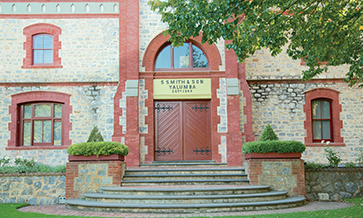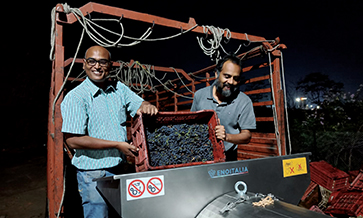Wine making is a long, natural process that requires little human intervention. But each winemaker guides the journey from grape to bottle with his expertise and perfected techniques. Oenology, the cellular counterpart of viticulture, involves the actual science of wine making, fuelling the landscape for vital research for global winemakers.
Kaushal was born in Nashik, the wine capital of India, and grew up surrounded by grape growers and wine producers. His innate curiosity egged Kaushal into attending an introductory 3-year wine-making course at Gargi Agriculture Research and Training Institute, Nashik, in 2008.
“I had the opportunity to take part in an internship at Nashik’s Vallée de Vin winery, which was life-changing. It compelled me to consider wine-making as a full-time career. I pursued a Master’s degree in Viticulture and Oenology from Montpellier SupAgro University (France) and Instituto Superior de Agronomia, in Lisbon (Portugal),” Kaushal tells me.
In 2015, he was chosen by Chandon’s Early Career Winemaker Programme and played assistant winemaker at Chandon’s India and Brazil wineries for a year each.
Currently, he is focusing on using existing tools of wine-making for different purposes – from using ion exchange, clarifying agents and yeast culture to bringing in modern practices at Chandon India’s vineyards in Dindori region outside Nashik.
What are the principal grape varieties Chandon India uses? What are the grape varieties Kaushal would like to see grown in India?
“The grapes that do well here are Shiraz and Chenin Blanc. Pinot Noir and Chardonnay have some challenges due to India’s hot climate; but they contribute significantly in terms of quality,” Kaushal says.
He adds: “Appropriately for India, our palette is more colorful here than at other Chandon houses. India is the only Chandon estate to use Chenin Blanc in its Brut because we found this grape delivers excellent quality.”
Around 70% of the assemblage in Chandon India’s Brut is Chenin Blanc. It makes a sparkling wine with a delicious fruity palate, with zesty acidity and freshness. “It’s a distinctive characteristic of the wine of this region – a showcase of India, if you like,” Kaushal smiles.
He prefers to work more on the varieties that are already doing very well for Chandon India. Even with Chenin Blanc and Shiraz, Kaushal is focusing on better understanding of their maturity, interaction of different regions and quality of wines produced from them.
International trends
Where does he see the Indian wine industry heading in the coming years? For Kaushal, these are exciting times to be in wine-making. “Our consumers are evolving; there is a sense of curiosity and excitement towards wine; people are looking for more opportunities to celebrate and craft memories,” he says.
Premiumisation has been the predominant task over the last few years, with a continuous quest for quality wines made with sustainable methods of production.
The best part of working with Chandon has been the exchange of ideas between all the wineries and winemakers. Some of Kaushal’s colleagues around the world have been working for 30 or 40 years for Chandon. They are all connected to a digital platform for exchange of ideas. “That’s a wealth of knowledge to tap into!” Kaushal feels.
Many of the wine-making regions have identified their terroir, climatic conditions, suitable grape varieties and soil compositions. “It is important to appreciate our region, our climate and start adapting our wine-making practices towards it,” feels Kaushal.
India’s challenges
Being away from the traditional grape belt zone, India has some issues with following the traditional way of grape growing. “Our viticulture is defined by pruning two times a year, a lack of vine dormancy and the pressure of disease, caused due to the wet season. Unseasonal rainfall also leads to vine rot and mildew,” he notes.
Increasingly, there is major variation in the climate year on year. “Climate change due to global warming causes unseasonal and late rainfall and variations in the pattern, affecting overall vineyard practices,” he says.
The Covid-19 pandemic has also impacted the wine industry, causing severe disruption. It has forced Chandon India to adapt to new ways of working. “Especially for those like me, who are closely associated with operations, it has has pushed us to come up with new ideas to manage operations,” Kaushal says.
Today social media and digital platforms are being utilised more by the industry, helping people connect and communicate about wine-making. Online tasting and virtual wine-making sessions are the new ‘normal’.
Direct-to-consumer selling, states governments that have permitted home delivery of alcohol, and increased digital presence are some positive outcomes of the current circumstances, according to Kaushal.
While the industry has not seen a major decline, many regions of India are still under lockdown, even after almost a year, and so Kaushal says it is too early to make any predictions.
Guru gyaan
For a wine enthusiast wanting to be a part of the industry, what is the one piece of advice Kaushal can offer? “This is an interesting field that demands patience, creativity and spontaneity. Visiting local vineyards and wineries to learn can be the first step to entering this field,” he says.
People should explore different regions, research online information, read books and take time tasting a lot of different wines. Educational courses related to wine-making and viticulture are also a great way to learn ; but nothing can replace hands-on learning by working in a winery during the harvest season.
How does the wine profile change from country to country where Chandon makes it? “Chandon now calls four continents its home. We are a worldwide family; together, yet separate; sharing our knowledge and united by inspiration,” he says.
While Chandon’s winemakers share the same techniques, the six houses produce a range of different styles of sparkling wine due to the varying climates and grape varieties available. Local products tend to please local palates.
“There is an ecosystem of demand and production – it’s even part of the definition of terroir. It’s not just physical – the sub-soil, the climate – it’s cultural, too. The key to our wine-making is in the local elements that we safeguard,” Kaushal says.
Overall, Chandon sparkling wines are are fresh and fruity, with just enough complexity and good acidity. They’re approachable and easy to drink, according to Kaushal.
Brazil Vs India
Brazilian sparkling wine has been trending for quite some time now. How would Kaushal compare wine-making in Brazil and India?
Kaushal, who also worked with Chandon Brazil, says : “Brazil has a lot of diversity in terms of sparkling wine-making. They have very easy drinkable bubbles, Prosecco style, Frizzante, Moscatos, and even very sophisticated style vintage and non-vintage wines.”
A majority of the wineries in Brazil are located in the southern-most part of the country, in a region called Serra Gaucha. The region is cool, hilly and has a temperate climate.
Brazil has a long history of sparkling wine-making. In India sparkling wine-making is still in its nascent stage. “We rely more on Chenin Blanc and Shiraz, while Brazil uses Chardonnay, Pinot Noir and Muscat grown there,” Kaushal tells me.
India is unique among Chandon’s properties in that it has a tropical climate. The monsoon hits the highly fertile Nashik area from June to September, bringing an average rainfall of 900mm.
However, Kaushal adds, harvest takes place between January and March, at the same time as in Chandon’s southern hemisphere estates in Argentina, Brazil and Australia.
In India there is no natural dormancy in the vines, so they’re pruned twice a year. On the approach to harvest, the diurnal temperature range increases, with cool, fresh nights conserving acidity alongside ripeness.
Nashik region is characterised by mild winter, resulting in a major temperature difference between day and night during grape ripening. This helps in conserving the freshness and acidity.
The red soil of the region is characterised by moderate water holding capacity, resulting in the perfect balance of canopy and fruit level.
On sustainability
Kaushal says winemakers need to be minimalistic. “I personally prefer that nature run its course rather than relying on external additives in the wines. We recycle the water and disinfectant for the next tank. The same water is used to clean floors with pressure guns,” he informs me.
Chandon’s vineyards in Dindori retain the cover crop in the rainy season to avoid soil erosion and rainwater runoff, and to increase groundwater reserves. The vineyards are fully drip-irrigated; and the pruned cane material, removed grass and landscape waste is used for compost.
“We are actively reducing our use of chemical herbicides by moving to mechanical weed management, and use of decomposed cow dung, mushroom compost, rock phosphate and bone meal to improve soil health and productivity,” Kaushal says.
In the vicinity of Chandon’s vineyards the winemaker has initiated a range of community schemes focusing on waste management, recycling and awareness. Trained community teams compost waste, recycle anything they can, and dispose all other waste responsibly.
Up to 25% of energy comes from Chandon’s 150-kW roof-top solar installation. “There’s always more to do, and we at Chandon India are always on the lookout for better ways to serve Mother Nature,” Kaushal adds.
Brut and Rose
Chenin Blanc is the first choice of winemakers for bubbly production in India for its crisp and clean finish. What characters do Chardonnay and Pinot Noir bring to Chandon India’s Brut?
“Chenin Blanc and Shiraz are emblematic for us at Chandon India for our Brut and Rosé. They reflect the typical fruit characteristics and terroir of Nashik region,” Kaushal says.
Chandon Brut comprises of 70% Chenin Blanc, 15% Chardonnay and 15% Pinot Noir. This results in an elegant expression of the Chandon style with a fresh bouquet of citrus blossom, green apple and hints of tropical fruit and vanilla.
For the Rosé, Chandon focuses on 100% Shiraz, resulting in intense red fruit forwards, creamy persistent sparkling.
But isn’t Pinot Noir one of the most difficult grapes to manage in India ? “Yes, Pinot Noir is challenging. It is sensitive to heat and relatively early to bud-burst. Being a thin-skinned grape it can shrivel and burn due to excess sun exposure and it gives lower yield per vine,” Kaushal admits.
Another challenge for this grape variety is that during the monsoon it tends to suffer from rot and mildew due to its tight bunch. “For us it has been important to have the open canopy, vineyard orientation towards balanced sun exposure, better aeration in the vineyard, and trying to achieve the right balance between leaves and fruit,” he adds.
Kaushal and his farmers also harvest it very early in the season, around January, when Nashik is relatively cold. Due to government regulations on grape sourcing, Kaushal relies heavily on contract farmers.
On a light note, I ask him, “If you could grow grapes on Mars, what would you name your wine?”
Kaushal shoots back : “I would call my Mars wine ‘Gaia’, to express my gratitude towards Mother Earth. In Greek mythology our planet is personified as Gaia.”














